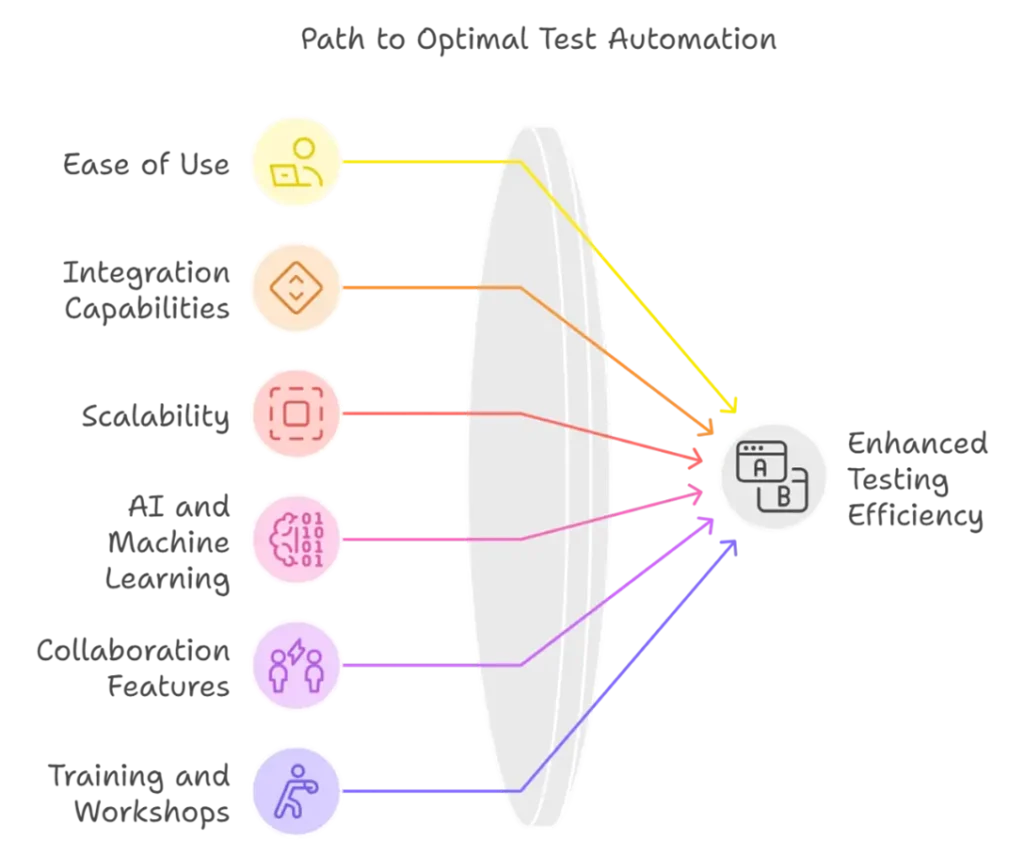
As technology continues to evolve, the need for efficient and accessible robotic process automation strategies becomes increasingly crucial for enhancing test web applications through robust test management. In 2024, low code test automation tools are set to revolutionize the way organizations approach their automation needs, particularly in AI-driven test strategies that require testing with minimal coding. By leveraging low-code platforms, businesses can streamline their testing processes, enhance collaboration, and ultimately drive innovation. This blog post explores the benefits of low-code automation and provides an overview of the trends shaping automation tools in 2024.
Introduction to Low Code Automation

What is Low Code Automation?
Low code automation refers to the development and deployment of automation solutions with minimal hand-coding. This innovative approach allows users to create applications and automate processes through graphical user interfaces and configuration rather than traditional programming. By democratizing automation, low-code automation tools empower non-technical users to participate in automation efforts and maintain test steps efficiently. This shift not only accelerates development cycles but also significantly reduces the reliance on specialized developers, enhancing overall productivity within organizations through an effective automation platform.
Benefits of Low-Code Solutions
Low-code solutions offer several key benefits that can transform how organizations manage their workflows. Among these advantages are faster development times and reduced costs, making it easier for companies to adapt to changing business needs while managing test steps effectively through robust test management. Additionally, low-code platforms often include built-in templates and reusable components, which facilitate efficient test creation and collaboration among teams. As a result, organizations can automate testing more effectively, achieve better test coverage, and streamline their overall testing process, including maintaining test data through code-less automation.
Overview of Automation Tools in 2024
In 2024, automation tools are expected to evolve significantly, especially with the integration of artificial intelligence and machine learning capabilities. These enhancements will empower automation tools to analyze data more effectively, predict failures, and improve decision-making processes within the test automation platform. The demand for low-code test automation tools will also rise as businesses increasingly seek to enable a broader range of employees to contribute to automation initiatives, particularly in API testing. This shift will lead to more innovative and agile organizations capable of managing their automation projects with greater efficiency, particularly through low-code test automation solutions.
Understanding Test Automation Tools

Definition of Test Automation Tools
Test automation tools are software applications designed to automate the testing process of software applications, including API testing and web testing. These tools enable testers to execute tests effectively, compare actual outcomes with expected results, and report defects promptly. By utilizing a robust test automation platform, teams can significantly improve the efficiency and effectiveness of their testing efforts. The ability to run repetitive tests quickly and reliably is crucial in today’s fast-paced development environment, ensuring higher software quality and faster release cycles through automation frameworks. As organizations adopt these tools, they pave the way for enhanced automation testing practices that contribute to overall project success and the effectiveness of tools like Selenium.
Importance of Automation Testing
Automation testing plays a crucial role in modern software development by increasing test coverage, reducing manual effort, and enhancing accuracy. The capability to execute many test cases in a short time frame is critical for continuous integration and continuous delivery (CI/CD) practices that organizations are increasingly adopting. Furthermore, automation testing improves the consistency of test execution, leading to more reliable results and quicker identification of defects. As businesses seek to optimize their testing processes, the role of automation tools becomes indispensable in maintaining high standards of software quality while accelerating time-to-market for new features and applications.
Comparison of Low-Code vs Traditional Testing Tools
Low-code testing tools differ from traditional testing tools primarily in their accessibility and ease of use. While traditional tools often require extensive programming knowledge and can be complex to set up, low-code tools enable users to create tests through intuitive interfaces and drag-and-drop functionalities. This shift allows teams to implement testing faster and with less reliance on specialized skills, utilizing tools like low code automation. Moreover, low-code and no-code solutions foster collaboration between technical and non-technical team members, making it easier for organizations to leverage diverse talents in their automation projects. Consequently, businesses can achieve greater efficiency in their testing processes, leading to more effective software testing outcomes using a robust test automation platform.
Top Low Code Test Automation Tools in 2024

Key Features of Leading Low Code Tools
Leading low-code application platforms in 2024 are defined by several key features that enhance their usability and effectiveness in codeless automation. One significant characteristic is visual test creation on a low-code application platform, which allows users to design tests through intuitive interfaces, minimizing the need for extensive coding knowledge. Additionally, these tools often integrate seamlessly with CI/CD pipelines, facilitating automation testing as part of the development and testing lifecycle, especially for cross-browser testing. Support for various testing types, including functional, performance, and security testing, ensures comprehensive coverage and effective test maintenance, particularly in the context of end-to-end testing. Furthermore, analytics dashboards provide insights into test results, while collaboration features enable teams to communicate efficiently, fostering a more cohesive approach to test automation.
Performance Testing with Low-Code Automation
Performance testing utilizing low-code automation tools empowers teams to simulate user activity and evaluate application performance under diverse conditions, supporting end-to-end testing. These platforms can automatically generate load tests and analyze performance metrics, providing valuable insights into potential bottlenecks. By leveraging low-code solutions, organizations can conduct performance testing more frequently and efficiently, ensuring applications meet user expectations and adhere to service level agreements through comprehensive test scripts. This proactive approach to performance management enhances software quality and user satisfaction, making it a critical aspect of modern application development practices, especially in code less test automation. With the ability to quickly adapt tests to changing requirements, low-code automation tools are essential for maintaining optimal application performance and supporting ai-driven test initiatives.
Case Studies of Successful Implementations
Numerous organizations have successfully leveraged low-code test automation tools to streamline their testing processes and achieve tangible results. For instance, a financial services company employed a low-code platform for automating regression testing, which led to a remarkable 40% reduction in testing time. Another case study highlighted a retail company that integrated low-code automation into its CI/CD pipeline, resulting in accelerated release cycles and improved product quality. These examples underscore the benefits of adopting low-code solutions across different industries, showcasing how they enable organizations to enhance their testing strategies and achieve greater efficiency in their automation projects.
Low-Code Test Automation Tools: A Deep Dive

How to Choose the Right Low-Code Test Automation Tool
Selecting the appropriate low-code test automation tool requires careful consideration of various factors, including ease of use, integration capabilities, and support for diverse testing types. Organizations should evaluate their specific testing needs, team skill levels, and existing workflows to ensure the chosen testing platform aligns with their objectives. Scalability is another critical aspect, as the tool must be flexible enough to adapt to evolving testing demands. By conducting thorough assessments and involving relevant stakeholders in the decision-making process, organizations can make informed choices that enhance their testing efficiency and overall project success.
Integrating Low-Code Automation into Existing Workflows
Integrating low-code automation tools into existing workflows can significantly enhance productivity and foster collaboration across teams, particularly in functional testing and cross-browser testing. To achieve this, it’s essential to engage stakeholders from various departments to ensure that automation initiatives align with overarching business objectives, especially when implementing an automation framework. Conducting training sessions and workshops can facilitate knowledge transfer, empowering team members to utilize low-code tools effectively, and low-code automation. Additionally, establishing clear processes for maintaining and updating automated tests will ensure their continued effectiveness over time. By prioritizing a collaborative approach and providing adequate training, organizations can successfully integrate a low-code test automation platform into their workflows, maximizing its benefits.
Future Trends in Low-Code Test Automation
As we look ahead, future trends in low-code test automation are likely to be characterized by greater integration with artificial intelligence and machine learning. This integration will enable predictive analytics and smarter test case generation, further enhancing testing efficiency. There will also be a growing emphasis on improving collaboration features to support remote and distributed teams, addressing the changing dynamics of the workforce in relation to functional testing. As agile methodologies continue to gain traction, low-code tools will evolve to offer even greater flexibility and efficiency in testing processes, ensuring organizations can adapt to market demands and maintain high-quality software delivery.
Exploring No-Code and Minimal Code Testing Solutions

What is No-Code Test Automation?
No-code test automation refers to the creation of automated tests without any coding requirements, allowing users to design tests through visual interfaces. This approach is particularly beneficial for business users and stakeholders who may lack technical skills but are familiar with the application under test. No-code solutions enable rapid test creation and execution, making them ideal for organizations looking to empower their entire workforce in testing efforts, especially in maintaining test data. By simplifying the testing process, no-code automation tools can bridge the gap between technical and non-technical users, enhancing collaboration and innovation.
Advantages of No-Code Solutions
No-code solutions offer several advantages, including increased speed of implementation, accessibility for non-technical users, and reduced dependency on development resources while simplifying test steps. By allowing users to create and modify tests without coding, organizations can adapt quickly to changes in requirements and ensure that testing keeps pace with development. Additionally, no-code tools often come with pre-built templates and components, further streamlining the testing process for various test applications. This user-friendly approach not only boosts productivity but also encourages more stakeholders to engage in the testing process, thereby improving test coverage and overall software quality through codeless automation.
When to Use No-Code vs Low-Code Automation Tools
Choosing between no-code and low-code automation tools depends on the complexity of the testing requirements and the technical expertise of the users in relation to the test scripts. No-code tools are ideal for straightforward testing scenarios where business users can easily design tests. In contrast, low-code tools may be more suitable for complex testing that requires customization and advanced functionalities, allowing technical users to leverage their coding skills while still benefiting from a visual interface. Understanding the specific needs of the project can help organizations make informed decisions, ensuring that they select the appropriate tools for their automation projects.
Conclusion
Summarizing the Benefits of Low-Code Test Automation
Low-code test automation tools provide significant benefits, including increased efficiency, faster time to market, and enhanced collaboration between technical and non-technical teams. They enable organizations to automate repetitive tasks, allowing testers to focus on more strategic testing activities within their test suite. By empowering a broader range of users to participate in automation efforts, low-code solutions help organizations respond more effectively to changing business needs. As organizations embrace low-code automation, they can improve their testing processes, leading to higher software quality and more successful project outcomes.
Looking Ahead: The Future of Automation Tools
The future of automation tools is expected to be shaped by advancements in AI, machine learning, and integration capabilities, enhancing their automation capabilities. As organizations increasingly adopt agile practices, automation tools will need to evolve to support rapid development cycles and continuous testing. Furthermore, the growing emphasis on user experience will drive the development of more intuitive interfaces, making automation accessible to a wider audience. These advancements will likely make low-code and no-code solutions even more powerful, enabling organizations to enhance their automation strategies and achieve greater efficiency in their testing processes.
Final Thoughts on Test Automation in 2024
As we move into 2024, the landscape of test automation will continue to evolve with the adoption of low-code and no-code solutions. These tools offer enhanced capabilities for organizations to automate end-to-end testing of web applications with minimal effort. Compared to other tools in the market, modern testing platforms are revolutionizing how teams create and test applications without writing any code, making reliable testing more accessible than ever.
Embracing the Low-Code Testing Revolution with iTAF

iTAF stands out as a powerful test automation tool designed to transform testing processes. The platform allows users to create comprehensive test scenarios without writing a single line of code, significantly streamlining the automation journey. What sets iTAF apart is its ability to facilitate end-to-end testing across various platforms while ensuring robust test maintenance. These tools allow users to create sophisticated test cases that would traditionally require extensive coding knowledge, making testing more efficient and accessible.
By embracing innovative approaches like iTAF, businesses can enhance their testing processes, improve software quality, and accelerate time to market. The integration of advanced technologies in test management will further empower teams to automate testing effectively, leading to more successful software development projects. This evolution in testing methodologies ensures organizations can stay competitive in an increasingly digital world while maintaining high standards of quality assurance.